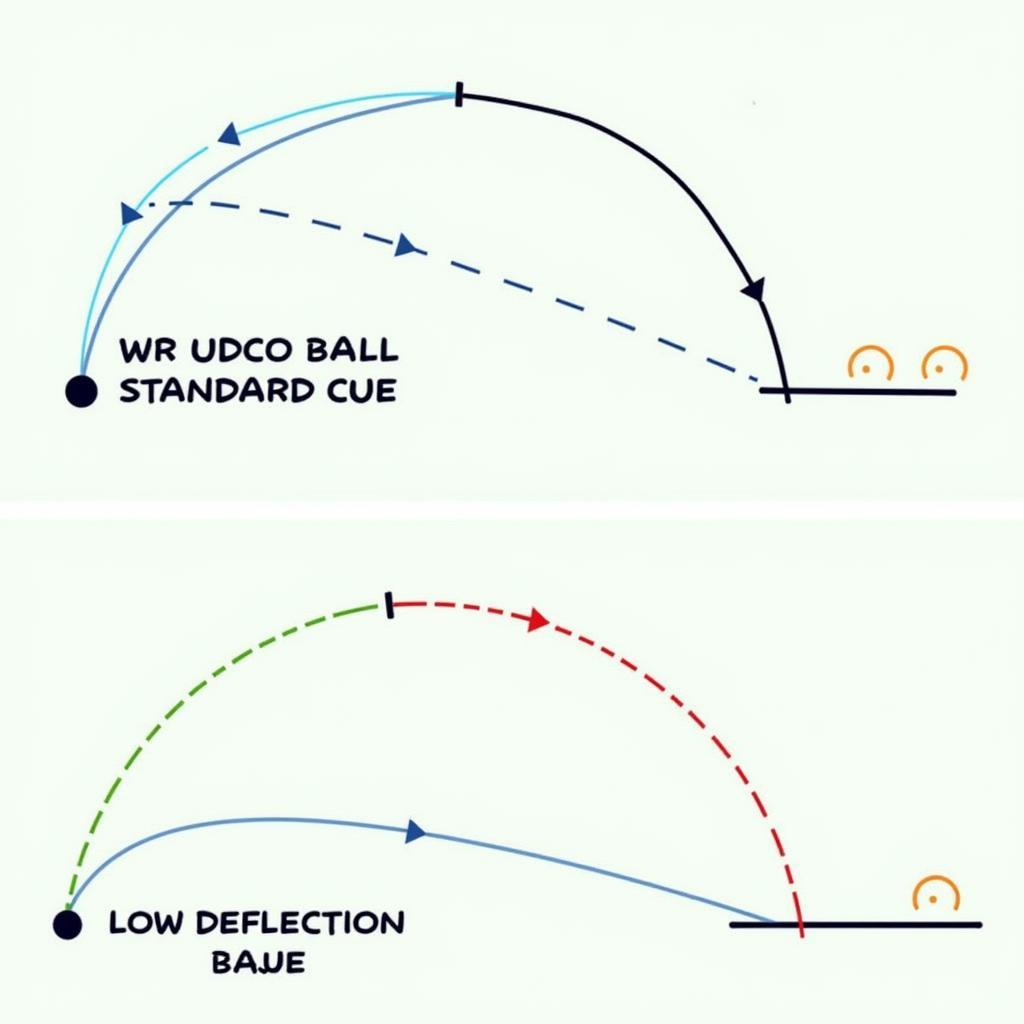Mastering Low Deflection Cues: The Key to Unpredictable Shots
October 22, 2024Low Deflection Cues have become increasingly popular in recent years, and for a good reason. These cues are engineered to minimize cue ball deflection, resulting in more accurate shots, especially when using English or aiming at extreme angles. But what exactly is a low deflection shaft, and how can it elevate your game?
Understanding Cue Deflection
Before diving into low deflection cues, let’s clarify cue deflection itself. Imagine striking the cue ball with sidespin. Instead of moving perfectly sideways, the cue ball initially travels on a slightly curved path. This phenomenon, called cue ball deflection, occurs because of the friction and energy transfer between the cue stick, cue ball, and the cloth.
 Low Deflection Cue Diagram
Low Deflection Cue Diagram
Traditional cues, often made with a conical taper, contribute to greater deflection. The further the tip is from the center of the cue ball at impact, the more pronounced the deflection.
How Low Deflection Cues Work
Low deflection cues are designed to minimize this deflection, providing a straighter shot trajectory. They achieve this through various technological advancements in shaft construction:
1. Layered Shaft Construction
Many low deflection shafts feature a layered construction using different wood types or composite materials. This layering technique optimizes stiffness and energy transfer, reducing the energy lost through vibrations and side-to-side movement, thereby minimizing deflection.
2. Reduced Taper
Instead of a traditional conical taper, low deflection cues often incorporate a pro taper or less pronounced taper. By keeping the diameter of the shaft more consistent from the joint to the tip, the impact force is distributed more evenly, resulting in less deflection.
3. Specialized Tips
The type of tip used on a cue can also influence deflection. Low deflection cues frequently pair with harder, layered tips designed to further reduce energy loss at impact, contributing to a straighter hit.
Benefits of Using a Low Deflection Cue
The advantages of low deflection cues extend to players of all levels:
-
Increased Accuracy: The most significant benefit is the enhanced accuracy they provide. By minimizing deflection, these cues allow you to aim more confidently, especially on shots requiring English or those with sharp angles.
-
Improved Consistency: Low deflection cues contribute to a more consistent stroke by reducing variables that can affect your aim and accuracy.
-
Enhanced Spin Control: With less deflection, you gain more control over the cue ball, allowing for more precise spin shots and better position play.
Choosing the Right Low Deflection Cue
Selecting the right low deflection cue is a personal decision influenced by playing style, budget, and feel preferences. Here are some factors to consider:
-
Material: Low deflection shafts are typically crafted from wood like maple and ash, or composite materials such as graphite or carbon fiber. Each material offers a unique feel and performance characteristic.
-
Taper: As mentioned earlier, the taper of the shaft significantly impacts deflection. Consider trying different taper profiles to find one that suits your stroke and comfort level.
-
Tip: The tip is the final point of contact and plays a crucial role in deflection and feel. Experiment with different tip materials and hardness levels to find your preference.
Conclusion
Low deflection cues are not a magic bullet, but they offer a significant advantage by minimizing cue ball deflection and enhancing accuracy. While they might require a slight adjustment period, the improved consistency and control they provide can elevate your game to the next level. If you’re serious about improving your shot-making abilities, exploring the world of low deflection cues is undoubtedly a worthwhile endeavor.
FAQ
-
Do I need a low deflection cue to play well? No, many skilled players use traditional cues. However, low deflection cues can simplify aiming and enhance accuracy, especially for precise shots.
-
Are low deflection cues more expensive? Generally, yes, due to the advanced materials and construction techniques used. However, affordable options are available, and the increased accuracy might be worth the investment for some players.
-
Will a low deflection cue change my stroke? It shouldn’t drastically alter your stroke, but you might experience a slight adjustment period as you become accustomed to the different feel and reduced deflection.
-
How do I know if a cue is low deflection? Check the manufacturer’s description or ask a knowledgeable salesperson at a billiards supply store.
-
Can I use any tip on a low deflection shaft? You can, but pairing it with a tip designed for low deflection often yields the best results in minimizing deflection further.
Need Help Choosing the Right Cue?
Choosing the right cue is crucial for any billiards enthusiast. If you need assistance finding the perfect low deflection cue for your game, our team of experts is here to help. Contact us at Phone Number: 0915117113, Email: [email protected], or visit us at our store located at Tổ 3 Kp Bình An, Phú Thương, Việt Nam, Bình Phước 830000, Việt Nam. We offer 24/7 customer support to answer all your cue-related questions.